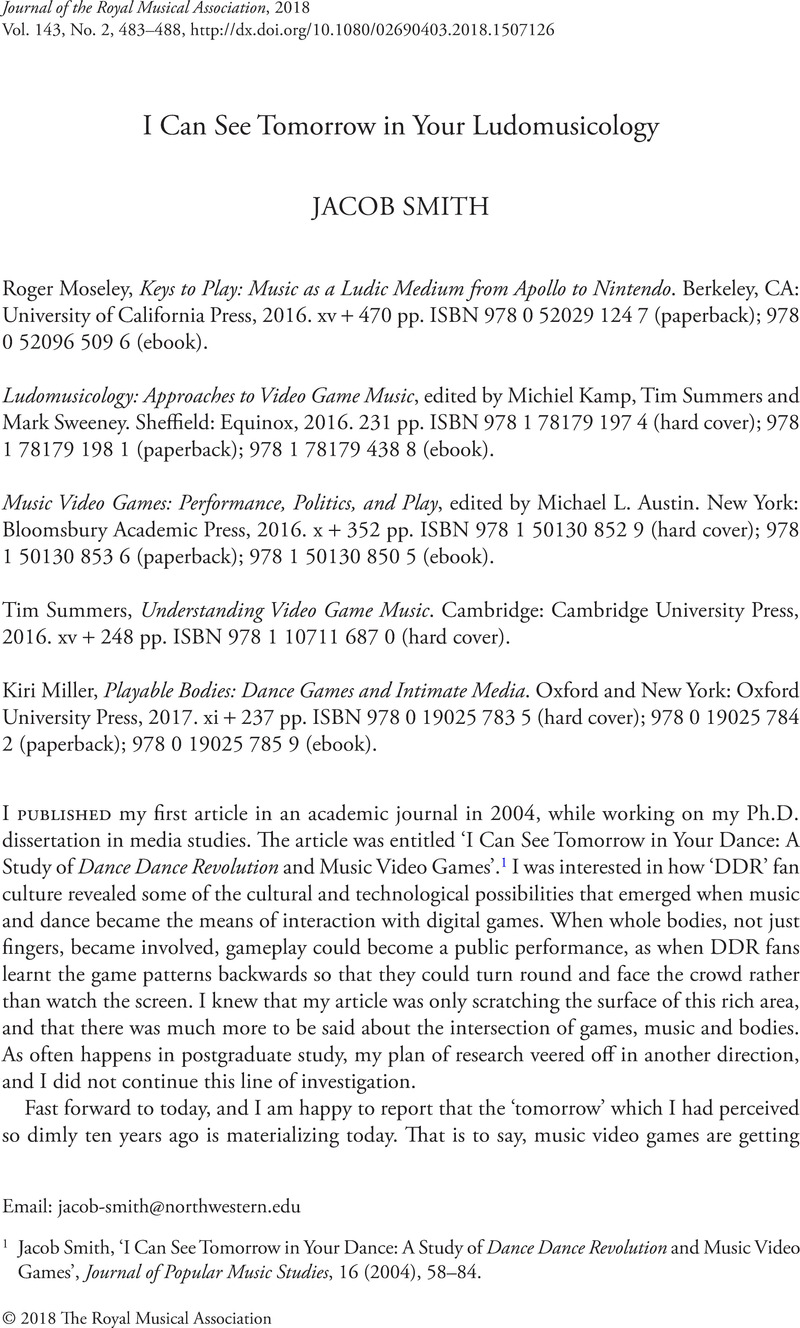No CrossRef data available.
Published online by Cambridge University Press: 01 January 2020

1 Jacob Smith, ‘I Can See Tomorrow in Your Dance: A Study of Dance Dance Revolution and Music Video Games’, Journal of Popular Music Studies, 16 (2004), 58–84.
2 Kamp, Summers and Sweeney, ‘Introduction’, Ludomusicology, ed. Kamp, Summers and Sweeney, 1–7 (p. 1).
3 Austin, ‘Introduction’, Music Video Games, ed. Austin, 1–22 (p. 2).
4 Quoted in Moseley, Keys to Play, 17. On Huizinga, see Austin, ‘Introduction’, Music Video Games, and Summers, Understanding Video Game Music, 3.
5 Moseley, Keys to Play, 16.
6 Ibid., 4, 61.
7 Rick Altman, The American Film Musical (Bloomington, IN: Indiana University Press, 1987), 95, 110.
8 Austin, ‘Introduction’, Music Video Games, 2.
9 Ibid., 12–13.
10 Summers, Understanding Video Game Music, 179.
11 William Cheng, Sound Play (Oxford: Oxford University Press, 2014); Summers, Understanding Video Game Music, 64–5.
12 Karen Collins, Playing with Sound (Cambridge, MA: MIT Press, 2013), 32. See also Miller, Playable Bodies, 7.
13 Miller, Playable Bodies, 15–16.
14 Summers, ‘Analyzing Video Game Music’, Ludomusicology, ed. Kamp, Summers and Sweeney, 8–31 (p. 9).
15 Kamp, ‘Suture and Peritexts’, ibid., 73–91 (p. 75). See also Summers, Understanding Video Game Music, 15–21.
16 Summers, Understanding Video Game Music. See also Summers, ‘Analyzing Video Game Music’, 10–13.
17 Katie Salen and Eric Zimmerman, Rules of Play: Game Design Fundamentals (Cambridge, MA: MIT Press, 2004), 99.
18 Don Ihde, Listening and Voice (Albany, NY: State University of New York Press, 2007), 73–83; Walter Ong, Orality and Literacy (London: Routledge, 1982), 72.
19 Jonathan Sterne, The Audible Past (Durham, NC: Duke University Press, 2003), 18.
20 Michel Chion, Audio-Vision: Sound on Screen, ed. and trans. Claudia Gorbman (New York: Columbia University Press, 1994), 150. See also Rick Altman's discussion of a sound's ‘signature’ in his Sound Theory/Sound Practice (New York: Routledge, 1992), 252.
21 Salen and Zimmerman, Rules of Play, 450.
22 Melanie Fritsch, ‘Beat It! Playing the King of Pop in Video Games’, Music Video Games, ed. Austin, 153–76 (pp. 166–7).
23 Isabella van Elferen, ‘Analyzing Game Musical Immersion’, Ludomusicology, ed. Kamp, Summers and Sweeney, 32–52 (pp. 33–6, 49). See also Summers, Understanding Video Game Music, 59.
24 Daniel O'Meara, ‘Rocksmith and the Shaping of Player Experience’, Music Video Games, ed. Austin, 229–49 (pp. 229, 243).
25 Miller, Playable Bodies, 1.
26 Ibid., 3.
27 Kiri Miller, Playing Along (Oxford: Oxford University Press, 2012), 4–5.
28 Miller, Playable Bodies, 171–2. See also Miller, Playing Along, 111–13.
29 Elizabeth Medina-Gray, ‘Modularity in Video Game Music’, Ludomusicology, ed. Kamp, Summers and Sweeney, 53–72 (p. 53).
30 Miller, Playing Along, 15, 93.
31 William Knoblauch, ‘Simon: The Prelude to Modern Music Video Games’, Music Video Games, ed. Austin, 25–42 (pp. 30–5).
32 Cheng, Sound Play, 37. See also Summers's section on ‘disinterested music’ in Understanding Video Game Music, 115.
33 Summers, Understanding Video Game Music, 60. See also Jeff Smith, Sounds of Commerce: Marketing Popular Film Music (New York: Columbia University Press, 1998), and Tim Anderson, ‘From Background Music to Above-the-Line Actor: The Rise of the Music Supervisor in Converging Televisual Environments’, Journal of Popular Music Studies, 25 (2013), 371–88.
34 Cheng, Sound Play, 113–37.
35 Moseley, Keys to Play, 1.
36 Mark Butler, Playing with Something that Runs (Oxford and New York: Oxford University Press, 2014).